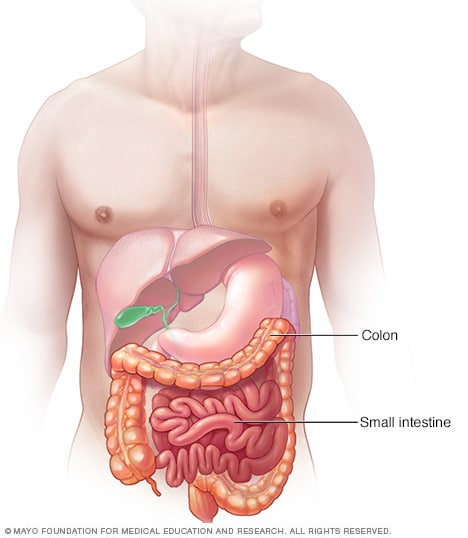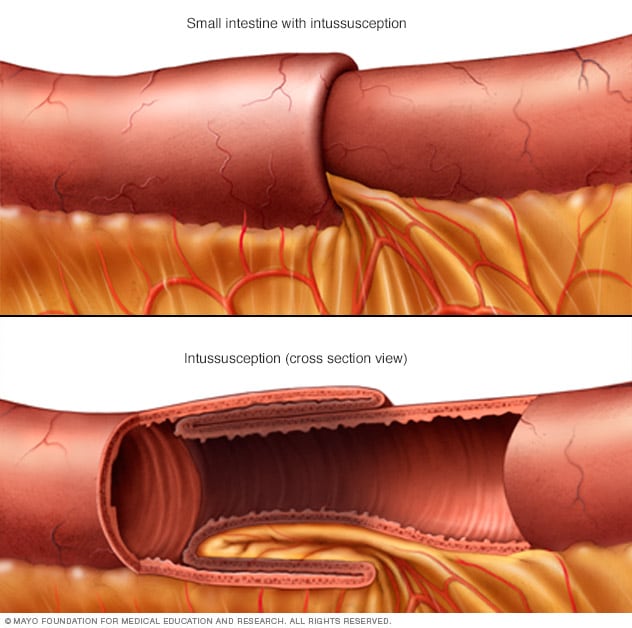Intestinal obstruction
Intestinal obstruction
overview
Large intestine and small intestine

Large intestine and small intestine
The small intestine and large intestine are parts of your digestive tract that process the foods you eat. The intestines remove nutrients from food. What is not absorbed by the intestines continues in the digestive tract and is excreted as stool during bowel movements. Diarrhea can occur due to abnormalities in the small intestine or large intestine.
Intestinal obstruction is a blockage that prevents food or liquid from passing through your small intestine or large intestine (colon). Causes of intestinal obstruction can include fibrous tissue bands (adhesions) in the abdomen that form after surgery; hernias; colon cancer; certain medications; or strictures from an inflamed intestine caused by certain medical conditions such as Crohn's disease or diverticulitis.
Without treatment, the blocked parts of the intestines can die, which can lead to serious problems. However, with timely medical care, an intestinal obstruction can often be treated successfully.
Symptoms
Signs and symptoms of an intestinal obstruction include:
- Krampfartige Bauchschmerzen, die kommen und gehen
- Appetitverlust
- Verstopfung
- Erbrechen
- Unfähigkeit, Stuhlgang zu haben oder Gas zu geben
- Schwellung des Bauches
When to go to the doctor?
Because of the serious complications that can develop from an intestinal obstruction, seek immediate medical attention if you have severe abdominal pain or other symptoms of an intestinal obstruction.
Causes
Intussusception

Intussusception
Intussusception is a rare, serious condition in which part of the intestine slips into an adjacent part.
The most common causes of intestinal obstruction in adults are:
- Darmadhäsionen – Bänder aus fibrösem Gewebe in der Bauchhöhle, die sich nach einer Bauch- oder Beckenoperation bilden können
- Hernien – Teile des Darms, die in einen anderen Teil Ihres Körpers ragen
- Darmkrebs
In children, the most common cause of intestinal obstruction is telescoping of the intestine (intussusception).
Other possible causes of intestinal obstruction include:
- Entzündliche Darmerkrankungen wie Morbus Crohn
- Divertikulitis – ein Zustand, bei dem sich kleine, pralle Beutel (Divertikel) im Verdauungstrakt entzünden oder infizieren
- Verdrehung des Dickdarms (Volvulus)
- Beeinflusster Kot
Pseudo-obstruction
Pseudo-intestinal obstruction (paralytic ileus) can cause signs and symptoms of intestinal obstruction but does not involve a physical blockage. In paralytic ileus, muscle or nerve problems disrupt the normal coordinated muscle contractions of the intestines, slowing or stopping the movement of food and liquid through the digestive system.
Paralytic ileus can affect any part of the intestine. Causes can be:
- Bauch- oder Beckenchirurgie
- Infektion
- Bestimmte Medikamente, die Muskeln und Nerven beeinflussen, einschließlich Antidepressiva und Opioide
- Muskel- und Nervenerkrankungen, wie die Parkinson-Krankheit
Risk factors
Diseases and conditions that may increase the risk of intestinal obstruction include:
- Bauch- oder Beckenchirurgie, die häufig Verwachsungen verursacht – ein häufiger Darmverschluss
- Morbus Crohn, der zu einer Verdickung der Darmwände und einer Verengung des Durchgangs führen kann
- Krebs in deinem Bauch
Complications
Untreated intestinal obstruction can cause serious, life-threatening complications, including:
- Gewebetod. Ein Darmverschluss kann die Blutzufuhr zu einem Teil Ihres Darms unterbrechen. Blutmangel führt zum Absterben der Darmwand. Gewebetod kann zu einem Riss (Perforation) in der Darmwand führen, was zu einer Infektion führen kann.
- Infektion. Peritonitis ist der medizinische Fachausdruck für eine Infektion in der Bauchhöhle. Es ist ein lebensbedrohlicher Zustand, der sofortige medizinische und oft chirurgische Behandlung erfordert.
Sources:
- Feldman M. et al., Hrsg. Darmverschluss. In: Gastrointestinale und Lebererkrankungen von Sleisenger und Fordtran: Pathophysiologie, Diagnose, Management. 11. Aufl. Elsevier; 2021. https://www.clinicalkey.com. Abgerufen am 7. Dezember 2020.
- Darmverschluss. Merck Manual Professional-Version. https://www.merckmanuals.com/professional/gastrointestinal-disorders/acute-abdomen-and-surgical-gastroenterology/intestinal-obstruction#. Abgerufen am 7. Dezember 2020.
- Kliegman RM, et al. Ileus, Adhäsionen, Invagination und Closed-Loop-Obstruktionen. In: Nelson Lehrbuch der Kinderheilkunde. 21. Aufl. Elsevier; 2020. https://www.clinicalkey.com. Abgerufen am 10. Dezember 2020.
- Darm-Pseudoobstruktion. Nationales Institut für Diabetes und Verdauungs- und Nierenerkrankungen. https://www.niddk.nih.gov/health-information/digestive-diseases/intestinal-pseudo-obstruction. Abgerufen am 10. Dezember 2020.
- Catena F, et al. Darmverschluss: Eine narrative Überprüfung für alle Ärzte. Weltjournal für Notfallchirurgie. 2019; doi:10.1186/s13017-019-0240-7.
- Fragen Sie MayoExpert. Invagination. Mayo-Klinik; 2019.
- Lied LM, et al. NSAIDs: Nebenwirkungen auf den distalen Dünndarm und Dickdarm. https://www.uptodate.com/contents/search. Abgerufen am 14. Dezember 2020.
- Rajan E (Gutachten). Mayo-Klinik. 11. Dezember 2020.

 Suche
Suche
 Mein Konto
Mein Konto